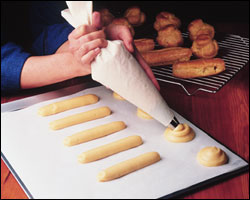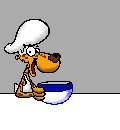Assumptions about Ingredients
The recipes in Chapters 17 through 21 always use certain common ingredients in the same way. For best results, follow these guidelines when preparing ingredients from these recipes:

Peel onions and garlic first. Because you almost always need to peel the papery skins off of onions and garlic before you use them, peel them before chopping (unless the recipe mentions otherwise).
Trim and use most of the green onion: Before using a green onion, trim off the root end and discard. The recipes in this book use all of the green section of a green onion—not just the white part—or as much as is fresh and usable. Green onions are also known as scallions.
Baking sheet, cookie sheet, and jelly roll pan

What's the difference between a baking sheet, sheet pan, jelly roll pan, and cookie sheet? These terms are often used interchangeably in recipes, because the pans themselves are similar, though not exactly the same.
I prefer the more generic term of baking sheet. When you see the words baking sheet in this book, you basically need to use a large, flat metal pan with low sides, from 1/2 to 1-inch deep, such as a jelly roll pan (shown with cookies going into the oven)—it usually measures 17x11 inches with 1-inch sides. In most cases, a metal baking pan of 16x12 inches with 1 to 2-inch sides also works well. Professional chefs use the term sheet pan for a low-sided pan that comes in full and half sizes. When you hear a chef on TV calling for a sheet pan, you're safe using a jelly roll pan.

Cookies, though, bake better on pans with low or no sides, so you can use a jelly roll pan, or if you have one, an actual cookie sheet. A cookie sheet, which will work best, has a very low lip on two opposite sides, mainly for easier handling, while the other sides are open for more even heating (see the photo). Cookie sheets range from 16x12 inches to 17x14 inches. Because the sides of a cookie sheet are open, never use it to cook anything with juices that can run over the edges.
To keep your work area dry and less messy, place your cutting board inside a low-sided pan, like a jelly roll pan, so that excess trimmings, spices, and spills fall into the pan. Place a damp towel under the cutting board or the pan to keep either one from slipping.
Use fresh, frozen, or canned vegetables and fruit: Fresh tastes best, but if fresh isn't available, substitute a frozen or canned version. Many of the recipes in Chapters 17 through 21 specify canned or frozen products because of their ready availability, but you can always substitute the fresh version. Get your fruits and veggies any way you can!
Don't peel most other fresh vegetables and fruits. Don't peel potatoes, carrots, apples, or other produce unless the recipe tells you to—most of the nutrients lie in or just under the skin.
Wash all fresh fruits and vegetables. To remove dirt and pesticide residue, rinse fruits and vegetables well, just before use (some foods, like berries, deteriorate if rinsed too far in advance). Scrub the skins of sturdier produce and remove and discard the outer leaves of lettuce and leafy vegetables. Dry the produce before using. See Chapter 8 for tips on rinsing vegetables, and whenever possible, use organic vegetables to avoid pesticides.
Keep nonstick vegetable spray handy. The recipes in this book frequently call for convenient nonstick vegetable sprays. If you don't have the spray handy, substitute a light coating of vegetable or olive oil, brushed on or wiped on with clean hands or with a paper towel.
Use low-salt varieties: These recipes are intended to be made with lower salt versions of canned broth, vegetables, and tomato products, usually found on the shelf next to their full-salt counterparts. If you use salted versions, cut back on the salt in the recipes.
Choose your fat content: Preferences vary widely on no-fat, low-fat, and whole milk products. For yogurt, milk, sour cream, mayonnaise, and cheeses, use the version you prefer. These recipes work fine with most low-fat versions, but most no-fat products (except for no-fat yogurt) are too far away from their natural counterparts to taste good.
Use large eggs: The recipes in this book assume that you'll use large eggs whenever eggs are called for.

Two halves make a whole chicken breast: A chicken has one breast, which is sold in two pieces, known as chicken breast halves or split-breasts. The ingredient lists in these recipes use the term chicken breast half when referring to the triangle-shaped breast pieces that you often find at the market.
The recipes in this book call for chicken breast halves.

Answer to the Fahrenheit conversion
In the "Cooking with Fahrenheit—a few degrees of separation" sidebar near the beginning of this chapter, I asked you to convert from Fahrenheit (F) to Celsius (C). Here's the answer.
To convert 350 degrees from Fahrenheit to Celsius, do the following:
Subtract 32 from 350 degrees: 350@nd32 = 318
Multiply 318 by 5: 418 x 5 = 1590
production: please insert the divided by sign instead of the slash in the following line. Thanks.
Divide 1590 by 9: 2090 / 9 = 176.66 (rounded up to 177 degrees Celsius)
So 350 degrees F equals 177 degrees C.

Search this site:
Recipes
About These Recipes
Breakfasts, Brown-Bags & Breads
Brown-Bag Barcelona Chicken
Buttermilk Basil Dressing
Chinese "Barbecued" Pork
Cool-as-a-Cucumber Dressing
(A No-Flame, No-Fire Recipe)
Cranberry-Cinnamon
Poached Pears
Green Onion French Bread
Happy, Dappy, Flappy Jacks
Irma's Spiced Nuts-to-You
Mango-Cheese Quesadilla
Mexican Fiesta Taco
or Burrito Mix
Orange-Scented Couscous
Tips
Ten Items for Your
Kid's Cookware Kit
Kid-Friendlier Recipes
About Ingredients
Cooking with Fahrenheit
Eating wine and spirits
Cookie sheet & jelly roll pan
More Cooking Tips
General Cooking Tips
Food at Hand: Eating
Finger Foods
Alexandria's Top Ten Cooking
Tips for Other Kids
Ten Kids-in-the-Kitchen
Commandments


